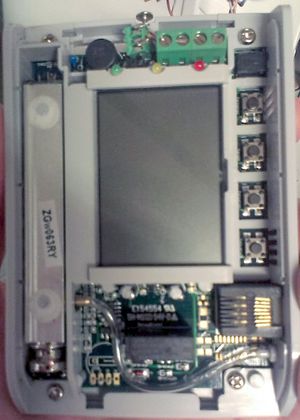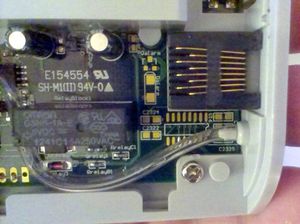CO2MeterHacking: Difference between revisions
mNo edit summary |
No edit summary |
||
| Line 16: | Line 16: | ||
[[File:Co-100_overview.jpg|thumb|right|CO-100 internals]] | [[File:Co-100_overview.jpg|thumb|right|CO-100 internals]] | ||
The CO2 sensor inside the CO-100 (in the left of the picture) has a sticker saying ZGw063RY. | The CO2 sensor inside the CO-100 (in the left of the picture) has a sticker saying ZGw063RY. | ||
Googling for this number reveals a CO2 module that looks just like the Voltcraft CO-100, so it appears that the CO-100 is basically | Googling for this number reveals a CO2 module that looks just like the Voltcraft CO-100, so it appears that the CO-100 is basically a rebranded [http://www.zyaura.com/products/ZGw063.asp ZyAura ZGw063RY] module. | ||
The CO-100 seems to miss a bunch of components that can be mounted on the PCB, close to the RJ45 connection (most likely an RS232 chip with charge pump capacitors). | The CO-100 seems to miss a bunch of components that can be mounted on the PCB, close to the RJ45 connection (most likely an RS232 chip with charge pump capacitors). | ||
| Line 25: | Line 25: | ||
On the bottom left of the PCB is a set of pads that are marked with G, C, D, V, meaning Ground, Clock, Data, Voltage of the ZG01 sensor. | On the bottom left of the PCB is a set of pads that are marked with G, C, D, V, meaning Ground, Clock, Data, Voltage of the ZG01 sensor. | ||
The voltage level on the clock and data pins is 3.3V (the voltage on V pin is | The voltage level on the clock and data pins is 3.3V (the voltage on V pin is 3.3V too). | ||
The ZG-01 sends 5-byte frames containing measurement values: | The ZG-01 sends 5-byte frames containing measurement values: | ||
| Line 66: | Line 66: | ||
|} | |} | ||
== Integration into Revspace infrastructure == | |||
Measurements of the CO2 meter are integrated into the existing infrastructure as follows: | |||
* The G, C, D, V lines from the ZG-01 have been broken out using a standard 2.54 pitch header | |||
* The ZG-01 ground, clock and data lines are attached to an arduino which decodes the ZG-01 protocol | |||
* Also attached to the arduino is an NRF24L01+ wireless transceiver, through which the CO2 measurement is sent to a central receiver (the one that also handles the Nomz-bell, Skip-button, etc.). | |||
== Hardware == | |||
The ZG-01 module and NRF24L01+ transceiver are connected to the Arduino as follows: | |||
{| class="wikitable" | |||
! Arduino | |||
! Module | |||
! Remark | |||
|- | |||
| D2 || 'C' || ZG01 clock signal | |||
|- | |||
| D3 || 'D' || ZG01 data signal | |||
|- | |||
| GND || 1 || NRF ground | |||
|- | |||
| 3V3 || 2 || NRF power | |||
|- | |||
| D8 || 3 || NRF CE | |||
|- | |||
| D9 || 4 || NRF CSN | |||
|- | |||
| D13 || 5 || NRF SCK | |||
|- | |||
| D11 || 6 || NRF MOSI | |||
|- | |||
| D12 || 7 || NRF MISO | |||
|- | |||
| - || 8 || NRF IRQ - not connected | |||
|} | |||
== Software == | == Software == | ||
The basic function of the software on the arduino is to wait until a CO2 measurement is received from the ZG-01, then send it using the wireless transceiver. | |||
=== ZG-01 decoding === | |||
The ZG-01 protocol is decoded using a simple state machine. | |||
On each falling edge of the clock line, a sample of the data line is taken until a total of 40 bits is received. | |||
If the time between a bit and the previous bit is longer than 2 milliseconds, it is assumed that a new 5-byte frame has started. | |||
=== Wireless protocol === | |||
To control the NRF24L01+ wireless transceiver, we use the | |||
[https://github.com/gcopeland/RF24a gcopeland fork of the RF24 library]. | |||
This library has several important fixes over the original RF24 library (and is used in the receiver as well). | |||
The wireless message consist of 7 bytes: | |||
0x06 "CO_2" <MSB> <LSB> | |||
=== Source === | |||
The source code can be found [https://github.com/bertrik/co2sensor on github]. | The source code can be found [https://github.com/bertrik/co2sensor on github]. | ||
== Future work == | == Future work == | ||
Future investigation: | Future investigation: | ||
* consider powering the Arduino from the 3.3V line coming from the CO2 sensor | * consider powering the Arduino from the 3.3V line coming from the CO2 sensor | ||
* investigate further into the unknown measurement items sent by the ZG01 | * investigate further into the unknown measurement items sent by the ZG01 | ||
* make a nicer case for the arduino+nrf module | |||
Revision as of 09:02, 30 March 2014
| Project CO2MeterHacking | |
|---|---|
| Status | In progress |
| Contact | bertrik |
| Last Update | 2014-03-30 |
Introduction
This project is about hacking the Voltcraft CO-100 CO2-sensor, such that we can read the exact ppm value as displayed on the LCD.
This particular CO2-sensor is present in the klusbunker at RevSpace and is currently used to control the ventilation in a crude manner (by monitoring the warning LEDs on the display module). Having the CO2 ppm value available as a number allows for nice things such as logging the levels over time, announce them on IRC, show them on the LedBanner , etc.
The user manual of the Voltcraft CO-100 says "Attention! The RJ45 connection (see chapter 7, item „K“) must not be used. The connection is only intended for the manufacturer". Of course, a claim like that can only be interpreted as a challenge! :)
Investigation & findings

The CO2 sensor inside the CO-100 (in the left of the picture) has a sticker saying ZGw063RY. Googling for this number reveals a CO2 module that looks just like the Voltcraft CO-100, so it appears that the CO-100 is basically a rebranded ZyAura ZGw063RY module.
The CO-100 seems to miss a bunch of components that can be mounted on the PCB, close to the RJ45 connection (most likely an RS232 chip with charge pump capacitors).

The CO2 sensor in the CO-100 is a ZyAura ZG-01 module. This sensor uses the ZyAura protocol, which vaguely resembles SPI, see File:ZyAura CO2 Monitor Carbon Dioxide ZG01 Module english manual-1.pdf.
On the bottom left of the PCB is a set of pads that are marked with G, C, D, V, meaning Ground, Clock, Data, Voltage of the ZG01 sensor. The voltage level on the clock and data pins is 3.3V (the voltage on V pin is 3.3V too).
The ZG-01 sends 5-byte frames containing measurement values:
- byte 0 is an identifier for the measurement item, e.g. whether it is a CO2 ppm value or a temperature.
- byte 1 and 2 contain the value of the item (byte 1 is the MSB, byte 2 is the LSB)
- byte 2 is a checksum over bytes 0-2, just the sum modulo 256.
- byte 3 is always 0x0D
Besides the CO2 ppm value and temperature, it also sends various other (so far unknown) measurement items.
Measurement items encountered so far:
| Item | Value | Remark |
|---|---|---|
| 0x41 'A' | 3290 | ? |
| 0x42 'B' | 4708 | Temperature in hexi-degrees Kelvin |
| 0x43 'C' | 2964 | ? |
| 0x46 'F' | 6882 | ? |
| 0x4F 'O' | 7754 | ? |
| 0x50 'P' | 857 | CO2 ppm value |
| 0x52 'R' | 10438 | Barometric pressure? |
| 0x56 'V' | 10443 | Barometric pressure? |
| 0x57 'W' | 7880 | ? |
| 0x6D 'm' | 2559 | Seems to always have same value |
| 0x6E 'n' | 17146 | ? |
| 0x71 'q' | 855 | Always close to value of item 0x50 |
Integration into Revspace infrastructure
Measurements of the CO2 meter are integrated into the existing infrastructure as follows:
- The G, C, D, V lines from the ZG-01 have been broken out using a standard 2.54 pitch header
- The ZG-01 ground, clock and data lines are attached to an arduino which decodes the ZG-01 protocol
- Also attached to the arduino is an NRF24L01+ wireless transceiver, through which the CO2 measurement is sent to a central receiver (the one that also handles the Nomz-bell, Skip-button, etc.).
Hardware
The ZG-01 module and NRF24L01+ transceiver are connected to the Arduino as follows:
| Arduino | Module | Remark |
|---|---|---|
| D2 | 'C' | ZG01 clock signal |
| D3 | 'D' | ZG01 data signal |
| GND | 1 | NRF ground |
| 3V3 | 2 | NRF power |
| D8 | 3 | NRF CE |
| D9 | 4 | NRF CSN |
| D13 | 5 | NRF SCK |
| D11 | 6 | NRF MOSI |
| D12 | 7 | NRF MISO |
| - | 8 | NRF IRQ - not connected |
Software
The basic function of the software on the arduino is to wait until a CO2 measurement is received from the ZG-01, then send it using the wireless transceiver.
ZG-01 decoding
The ZG-01 protocol is decoded using a simple state machine. On each falling edge of the clock line, a sample of the data line is taken until a total of 40 bits is received. If the time between a bit and the previous bit is longer than 2 milliseconds, it is assumed that a new 5-byte frame has started.
Wireless protocol
To control the NRF24L01+ wireless transceiver, we use the gcopeland fork of the RF24 library. This library has several important fixes over the original RF24 library (and is used in the receiver as well).
The wireless message consist of 7 bytes: 0x06 "CO_2" <MSB> <LSB>
Source
The source code can be found on github.
Future work
Future investigation:
- consider powering the Arduino from the 3.3V line coming from the CO2 sensor
- investigate further into the unknown measurement items sent by the ZG01
- make a nicer case for the arduino+nrf module